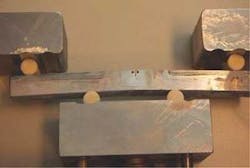POWDER METALLURGY: Trials confirm superior stress-resistance qualities of HIP steel
Nick Terdre, Contributing Editor
Tests commissioned by Metso Powdermet indicate that duplex steel subsea structures fabricated using hot isostatic pressing exhibit stronger resistance to hydrogen-induced stress cracking.
Comparative studies with conventionally forged structures were conducted earlier this year by the Sintef research institute in Norway, in collaboration with NTNU - Norwegian University of Science and Technology. A paper giving full results of the tests will be presented at the March 2007 conference of NACE, the National Association of Corrosion Engineers.
Hydrogen-induced stress cracking (HISC) has caused damage to stainless steel subsea structures on a number of fields, often causing lengthy and costly shutdowns while the damaged items are retrieved and replaced. Instances have been reported in the Norwegian sector on fields such as Garn West, Balder, Åsgard and Gullfaks Satellites, Tune and Tambar, and on Foinaven, Scott and Britannia, in the UK sector.
However, there have been no reports of HISC damage to subsea structures such as hubs and manifolds produced by Metso using hot isostatic processing (HIP), according to Göte Björman, product manager offshore.
Cathodic protection dilemma
Ironically, it is the method of protecting a subsea structure against corrosion that makes it susceptible to HISC. The cathodic protection system which guards against corrosion of the metal by its exposure to sea water involves passing a current through the structure. This creates hydrogen ions, the vast majority of which migrate into the material. The presence of hydrogen in duplex materials makes them susceptible to cracking - the phenomenon of hydrogen embrittlement. The actual occurrence of cracking is often triggered when the structure is subjected to heavy loading, for example when it is being installed at sea.
Cracking takes place in the ferrite phase of the metal, whereas the austenite phase resists cracking. Susceptibility to cracking is therefore related to ferrite unit size - the distance between the austenite grains. In this respect HIP and forged materials differ significantly. HIP material has isotropic properties (the same properties in every direction), the austenite and ferrite phases are uniformly distributed, and the spacing between the austenite grains is small.
In forged materials, on the other hand, the austenite and ferrite phases are more randomly distributed and the ferrite unit size is larger. Forged materials therefore present more favorable conditions for the propagation of a hydrogen stress crack than HIP materials.
The test program commissioned by Metso was designed to examine the comparative susceptibility of HIP and forged materials to cracking under conditions of cathodic protection. As one part of the program a fracture toughness test - evaluating the crack tip opening displacement - was performed on specimen 25Cr stainless steels made by the HIP method and forging.
Testing was performed by four-point bending of fatigue pre-cracked SENB (single edge notch bend) specimens at a cathodic potential of -1050 mV in 3.5% sodium chloride at 4°C. Three HIP materials, one duplex stainless steel (UNS S31803) and two super duplex stainless steels (UNS S32550 and UNS S32760) were investigated and compared with one forged super duplex stainless steel (UNS S32760) specimen.
The forged material showed signs of cracking after 21 days at a CTOD level of 0.033mm, when a crack extension of 1.6mm was measured. After 30 days, the nominal duration of the test, the HIP material showed no indication of cracking at this CTOD level, but a tendency towards cracking was observed at a CTOD level of 0.08mm, when a crack extension of 0.16mm was measured.
The results also showed that the speed with which a crack propagates is faster in forged material than in HIP material, according to Martin Bjurström, Metso Powdermet’s quality assurance and materials engineer. In an extended ferrite phase area such as is found in forged material, the cracking process develops more energy, which in turn makes it harder to stop when it hits austenite grains. In HIP material propagation is slower and is resisted more effectively when it meets austenite grains.
Testing supported the theory that a finer microstructure reduces the risk of HISC, Bjurström says.
The fine structure and size of the ferrite and austenite phases in HIP products is a result of the method of manufacture, he explains. When the powder is atomized at a very high temperature, the metal is solidified in fractions of a second. The number of new grains which is formed correlates with the speed of cooling and results in a fine material structure.
Metso has recently delivered stainless steel hubs to Hydro’s Fram East and Vilje projects and to Shell’s E3 Draugen project, all in the Norwegian sector. The E3 hubs were subjected to ultrasonic testing, which was partly carried out while the structures were immersed in water, under which conditions defects as small as 0.5mm can be detected, Bjurström says. HIP material is very easy to inspect by UT precisely because of the fine microstructure.
Further support for the low susceptibility of HIP material to HISC is provided by DNV, which in April issued guidelines for the design of subsea equipment in duplex steels to avoid this problem. As a result of its investigations DNV concluded that the microstructures found in forged materials with initial large section thicknesses and weld metals are more susceptible to HISC than those of rolled materials, cast materials and materials produced from powder metallurgy. HIP materials are one form of powder metallurgy.
For more information, contact Martin Bjurström, Metso Powdermet. Tel +46 220 34829, fax +46 220 33490,[email protected], www.powdermet.com

